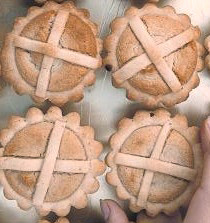Facts About Leipziger Lerche
The Leipziger Lerche is a delightful pastry originating from Leipzig, Germany, with a fascinating historical background. Originally, until the 1870s, the pastry was filled with actual songbirds known as larks. These birds were roasted with herbs and eggs, and in 1720 alone, a staggering 400,000 larks were sold in Leipzig for this dish.
However, in 1876, King Albert I of Saxony officially banned the hunting of songbirds due to their ecological importance. Despite the ban, the export of larks from Leipzig continued until the late 19th century. This prompted local pastry chefs to get creative, leading to the invention of a new, sweet version of the Leipziger Lerche to replace the traditional meat-filled one.
Today’s Leipziger Lerche is a delectable treat made with shortcrust pastry filled with a mixture of crushed almonds, nuts, and a cherry, which symbolizes the bird's heart. It is topped with two crossed strips of dough, giving it a distinctive appearance. Since 1998, the term "Leipziger Lerche" has been protected by the Saxonian Bakery Guild, ensuring the pastry's unique identity and authenticity.
The creation of this sweet version not only provided a delicious alternative but also contributed to the conservation of larks by offering a non-meat option following the hunting ban. So next time you find yourself in Leipzig, be sure to try this charming pastry with its rich and intriguing history!

 Denmark
Denmark